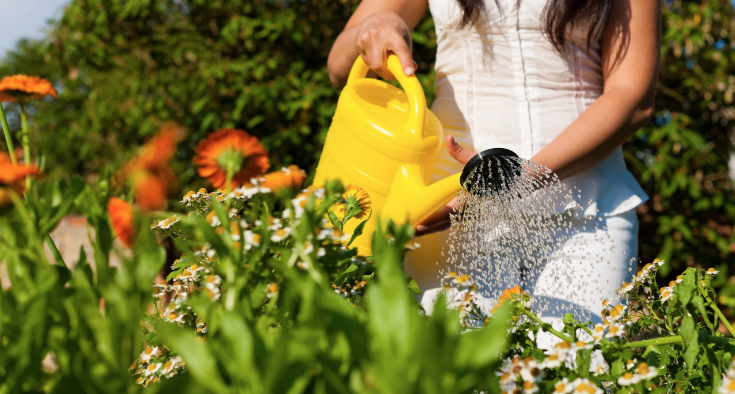
Gardeners are known to pore over seed catalogues and websites during the long winter—planning and plotting their garden’s layout and plantings. In most areas, April and May are the months when we condition the soil, dig, plant, fertilize, and water—with fingers crossed. June is the time of hoping and enjoying, as new growth springs from the soil, bringing life and color to what was not long ago just a barren patch or an assortment of empty containers.
While spring and early summer are usually when gardeners find themselves up to their elbows in the good earth, July and August should rightfully be the time to enjoy the sturdy plants, lustrous foliage, and a profusion of colorful blooms, but if soaring temperatures and diminished rainfall threaten your garden’s beauty in mid-summer, refresh and renew it using these flower gardening tips:
Water Carefully
During the peak of summer, flowers need a minimum of an inch of water each. If temperatures rise well above normal for your gardening zone, you may need to double or even triple these amounts. You can save water by using a soaker hose, or by watering earlier in the morning so foliage dries quickly and delivers maximum benefit to your plants.
Feed Appropriately
Annuals, especially late-summer bloomers like dahlias, need feeding right up until early October, when a hard front in the mid-Atlantic states is usually right around the corner. Other flowers need periodic nutrient boosts to continue through fall. Perennials—like black-eyed Susans, cornflowers, and Shasta daisies, for example—should be allowed to wind down throughout the summer. Do not force tender, new growth by fertilizing. If you have rose bushes that typically have a second bloom as cool weather approaches, feed those in the beginning of August.
Re-Mulch as Needed
The high temperatures of mid-summer can cause mulch to break down, causing what was once soft, rich soil to become hard and cracked. Protect your soil and your plants’ root systems by applying a fresh layer of mulch in mid to late July, taking care to keep the mulch a few inches away from the plant crowns.
Weed, Weed, Weed
Pulling weeds from soft, forgiving spring soil is a satisfying and rewarding garden task. Trying to keep weeds at bay when summer heat and lack of moisture seem to have cemented them into the ground is far less enjoyable. Try using a hoe to break up the root systems of well-established weeds, and at least remove the seed heads from weeds that can germinate and spread when cooler temperatures and fall rainfall return.
Guard Against Pests
Summer insect pests in the many gardening zones include beetles, spider mites, scale, and whiteflies—and they can be a real bane to your garden’s growth and beauty. Spider mites flock to flowers and foliage that are very dry, so mist your plants daily to discourage those. Try using yellow sticky traps to snag thrips, fungus gnats, and whiteflies.
Walk your garden in the early morning with a bucket of soapy water. Pick any obvious pests off your plants and drop them into the bucket. Try to use pesticides—even organic ones—sparingly; residue of pesticides left on your plants can cause burning as the sun gets hotter.
Control Diseases
When your flowers become stressed due to high temperatures and drought, they become more vulnerable to mildew and fungal diseases. Remove and destroy any leaves infected with black spot or mildew to keep spores from settling into the soil and multiplying. Selective pruning of overcrowded branches promotes disease-reducing air circulation.
If you find that you need to do so much throughout the summer to keep your garden beautiful and abundant that it becomes a chore, consider doing something radically different! Upend its timetable completely, and plant in mid-to-late summer instead of spring.
You’ll find great bargains at reputable garden centers after July 1. (Skip the big box stores with garden aisles in favor of the quality well-maintained plants usually found in bona fide garden centers—and avoid the leftover cool weather plants like pansies altogether; these plants are not likely to thrive at all now. Purchase fresh stock in the fall for these short-season plants.)
In mid-to-late July, try starting some cool weather fall flowers from seed—like nasturtiums, snapdragons, and flowering kale. Start seeds outdoors in a shady spot and keep the seeds/seedlings moist. If your garden faces due west or south, and your climate is clear and sunny, start your seeds indoors and transplant them after temperatures cool a bit in September.
